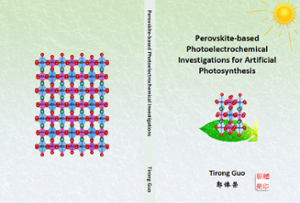Dissertation
Perovskite-based Photoelectrochemical Investigations for Artificial Photosynthesis
Inspired by natural photosynthesis, perovskite-based photoelectrochemical (PEC) systems are being developed for artificial photosynthesis, aiming to enhance solar-to-hydrogen conversion for green energy.
- Author
- T. Guo
- Date
- 21 January 2025
- Links
- Thesis in Leiden Repository

This dissertation focuses on the Ba₂Bi₂O₆ (BBO) double perovskite, a material with tunable chemical and structural flexibility, engineered to realize efficient solar energy conversion. Through controlled doping, film thickness optimization, and concentration adjustments, a series of BBO-based photoelectrodes with tailored band gaps, crystal structures, and varying PEC performances were systematically investigated. Doping with pentavalent Nb5+ and Ta5+ ions induced a rhombohedral crystal structure and increased band gaps (1.5-2.3 eV), enhancing electrochemical stability but yielding modest photocurrents. In contrast, doping with La3+, Ce4+, Pr3+/Pr4+, and Pb4+ ions led to monoclinic structures, while Y3+ doping resulted in a mix of monoclinic and cubic phases. The doped B1–O–B2 network remained highly ordered in La3+ and Y3+ systems, became partially ordered with Pr3+/Pr4+, and disordered with Ce4+ and Pb4+. Optical band gaps increased to 1.57 eV and 1.73 eV in La3+ and Pr3+/Pr4+ doped systems, respectively, compared to the parent BBO material. Notably, the La3+-doped system demonstrated improved electrochemical stability and superior photocurrents, offering promising insights for future optimization of PEC materials for sustainable hydrogen production.
